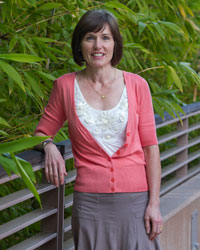Wellness after cancer: Stanford opens clinic to address survivors’ needs
Wellness after cancer: Stanford opens clinic to address survivors’ needs

Holly Gautier, RN, Program Manager of the Stanford Cancer Institute Supportive Care (left), talks about the Institute’s new Survivorship Clinic with its manager, Kelly Bugos, RN, NP, MS./Photo by Norbert von der Groeben
Janelle O’Malley has been cancer-free for eight years, a long time since the removal of a malignant tumor required a complete hysterectomy, sending her into menopause at age 49.
She jokes wryly about not feeling like a cancer survivor because she didn’t go through radiation or chemotherapy, but the aftermath of that surgery defines her as one of more than 12 million Americans who have had cancer. More than half the 1.5 million diagnosed with cancer this year will also prevail beyond that pronouncement, adding O’Malley to that growing population whose cancer often leaves lingering effects and is fueling a new dimension of cancer care – care for its survivors.
This month, the Stanford Cancer Institute opens its first Survivorship Clinic, at its Clinical Cancer Center, with O’Malley as one of its first patients. The clinic, which will focus initially on gynecologic cancer survivors, joins a small but growing number of such clinics, where all care is focused on wellness post-cancer treatment. “There’s a whole body of knowledge, and more importantly, a whole collection of needs that cancer survivors have,” said Douglas Blayney, MD, the Cancer Center’s medical director. “Some are common across tumor types and some are unique to various tumor types. We are trying to meet those needs and serve those patients.”
“Our health care system is much more geared to acute rather than chronic care and we haven’t had a good transition back to routine care,” said David Spiegel, MD, director of Stanford’s Center for Integrative Medicine and a long-time researcher on the interaction between the psychosocial and physiological impact of cancer. “People develop significant issues after cancer – the question becomes how to live with this for the rest of your life,” he said. “We want to develop a program to provide emotional and medical support for people who are beyond very acute care. Survivorship care should be there from day one.”
The focus of care will be on those areas already known to be present for most cancer survivors: fatigue, anxiety, body image, sexual function and relationships. At Stanford, a clinic patient will most likely be seen by a nurse practitioner she has already gotten to know during the course of initial treatment, said Kelly Bugos, a nurse practitioner who is establishing Stanford’s survivorship clinic. Should a concern arise beyond those issues, that patient will be seen quickly by an appropriate physician.
Initial patients will be limited to those who have had gynecologic cancers, like O’Malley. “We’ve set this up so we will be seeing patients we’ve been following for quite a while, with the expectation that they are cured or have a chance for a long-term remission,” said Jonathan Berek, MD, director of the Stanford Women’s Cancer Center and an internationally-known clinician and researcher in gynecologic cancers. “The focus will be on issues important to them: health maintenance, screening for other cancers and the psychological and physical adaptations for someone who has gone through the trauma of being diagnosed and treated with a life-threatening disease.”
Such patients don’t need to be seen by their oncologists, Berek said, “but we’re not relinquishing them. This is an adjunct to their care that maximizes the quality of their care because they’ll have someone who can spend more time with them, go over tests, get them involved in support groups they haven’t been involved with and pay more attention to those needs not related to a cancer recurrence.”

Kelly Bugos, RN, NP, MS, will be managing the new Survivorship Clinic at the Stanford Cancer Institute./ Photo: Norbert von der Groeben
“We’re ahead of the game because we have practice teams integrated around each patient’s cancer type,” Blayney said. “This means we will add to that team people with the special skills to meet our patients’ needs as they transition into survivorship, and weave them into the fabric of our care.”
Bugos has worked in cancer care at Stanford since 1989. “We’ve done a beautiful job of helping rid people of their cancer; the piece that’s been missing is helping them to return to wellness after treatment. It’s time for us to give people tools to make that transition and extend the treatment safety net a little bit longer. We know that when treatment ends, the cancer experience continues.”
Stanford’s Survivorship Clinic was developed after a year of study, site visits and discussions with experts from the LIVESTRONG Survivorship Center for Excellence Network. Established in 2005, it now collaborates with institutions like Stanford to create nationally-recognized standards and metrics of care. Stanford’s experience will become part of LIVESTRONG’s ongoing advocacy work in the field, Bugos said.
“The goal is to return to wellness, as defined by each individual,” she said. “To help focus our attention, and shape each visit, we developed a pre-clinic survey so we know what’s important to each patient. We want our treatment to be a partnership.”
“My path toward healing continues,” said O’Malley. “Once you have cancer, it embodies your spirit, your family, your friends, and your future. I am extremely thankful that I am a part of the new Survivorship Clinic.”
From the initial visit will come a plan, Bugos said. It will include when certain tests will be done and other relevant health issues to be addressed. Having a plan makes a difference. “Being diagnosed with cancer can make you feel out of control, but once you have a treatment plan, you can follow that plan,” she said. “Once that initial treatment plan is done, you can feel out of control again, so having a survivorship plan is important.”
Many of the resources Survivorship Clinic patients will learn about are part of supportive care programs and services at the Stanford Cancer Center and the Stanford Center for Integrative Medicine. The Survivorship Clinic also creates an additional layer of care opportunities through clinical research trials lead by Spiegel and Oxana Palesh, MPH, PhD.
Spiegel’s research into the psychosocial aspects of the cancer experience dates back 30 years. It was among the first to show that being part of a cancer patient support group made a significant impact on quality of life during treatment. Now, Spiegel, Palesh and their Stanford colleagues are leading research into the treatment of sleep disturbance, which 80 percent of cancer patients develop. It often endures beyond the finish of initial treatments and can contribute to subsequent health issues. Shelli Kesler, PhD, another collaborator in Spiegel’s group, is looking at the cognitive dysfunction related to chemotherapy, sometimes called cognitive fog or chemo brain. “We have a couple of trials open and are starting others,” Bugos said.
“The good news about disrupted sleep is that it’s treatable,” Palesh said. Another area of interest is how to treat the anxiety that can remain even after a patient is found to be cancer-free, she said. “It makes sense that people are apprehensive; not all cancers have very clear symptoms. And it can be bittersweet: You’re finished with treatments and congratulated but still expected to come back for check-ups.” The higher survival rate after a cancer diagnosis can mean it’s less “scary than it was 20 years ago,” she said. “The science of survival is very new – we haven’t done a lot of research – but we now have the luxury of doing it. We plan to become a program that offers the latest and best evidence-based interventions for our patients.”
By Sara Wykes
Stanford University Medical Center
###
> About Stanford Hospital & Clinics
Stanford Hospital & Clinics is known worldwide for advanced treatment of complex disorders in areas such as cardiovascular care, cancer treatment, neurosciences, surgery, and organ transplants. It is currently ranked No. 17 on the U.S. News & World Report’s “America’s Best Hospitals” list and No. 1 in the San Jose Metropolitan area. Stanford Hospital & Clinics is internationally recognized for translating medical breakthroughs into the care of patients.
###
* Stanford University Medical Center integrates research, medical education and patient care at its three institutions – Stanford University School of Medicine, Stanford Hospital & Clinics and Lucile Packard Children’s Hospital.
** The above story is adapted from materials provided by Stanford University School of Medicine
________________________________________________________________




















